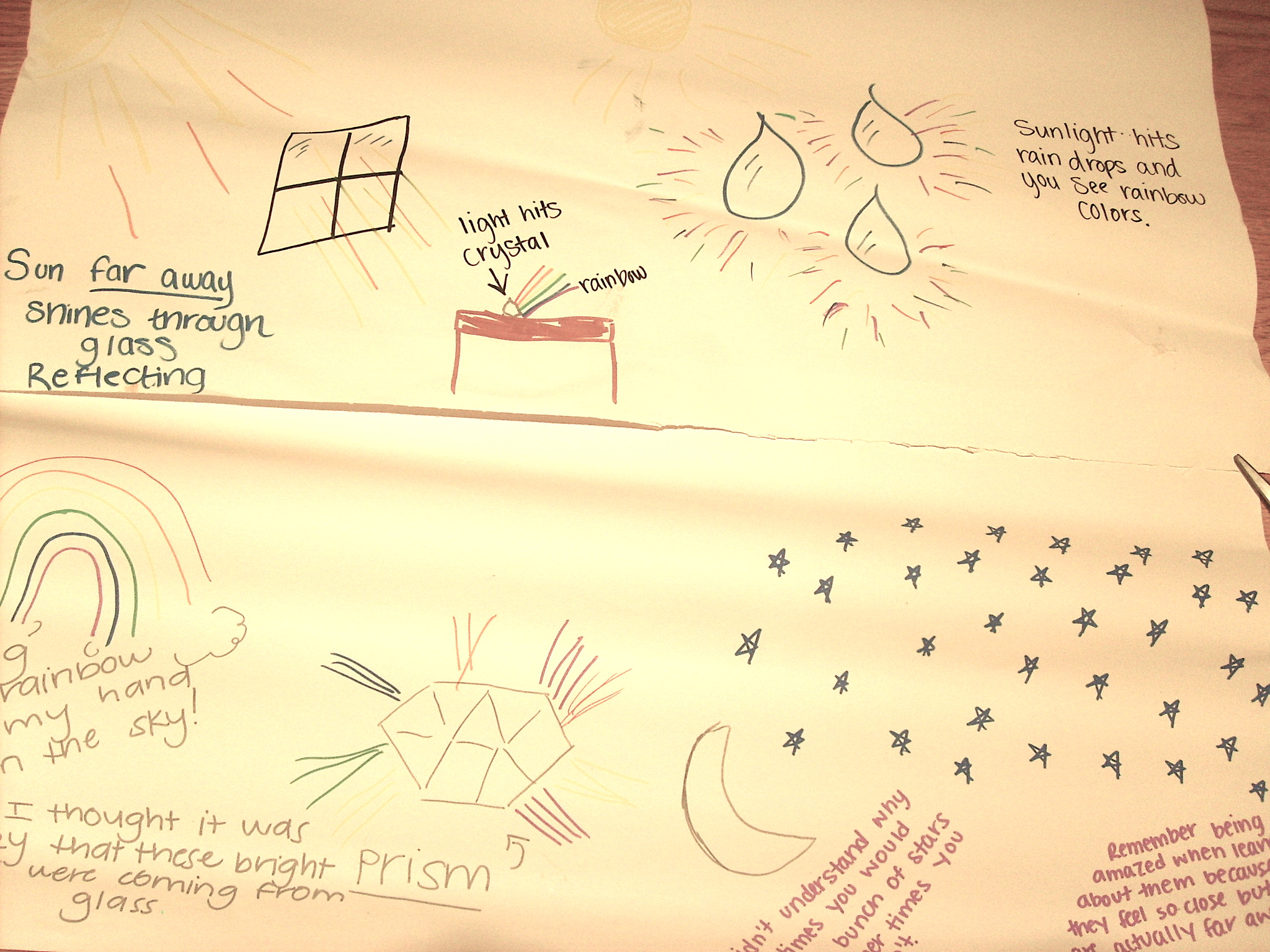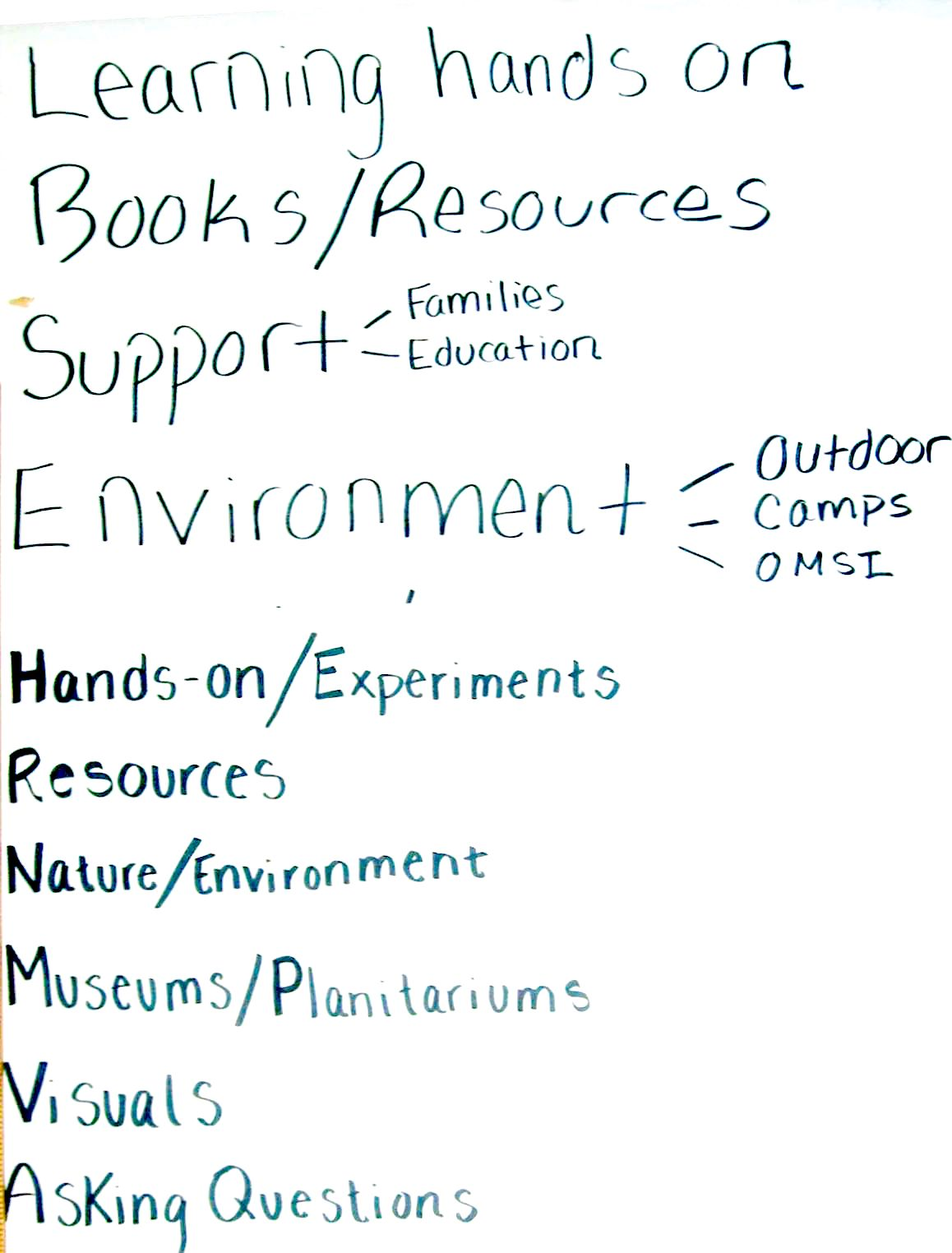Unit 1: Exploring the Nature of Light Phenomena
II. Identifying Student Resources
What do you already know about light? When did you learn this? Where were you? With whom? Why were you interested? How did this learning occur? These prior experiences in learning about light provide resources upon which you can draw in learning more about light in this course.
These “question words” –What? When? Where? Who? Why? and How? – represent an important aspect of science for which you are already expert in everyday life: asking questions. In this unit, you will explore questions that you and others generate about science learning in general and also about learning about light.
A. Learning about ways to foster science learning
Here is the first question:
Question 1.1 What have you learned about light at some time in your life, inside or outside of school, during an experience when you enjoyed the learning process?
- What did you learn about light? How did you learn this? With whom were you learning? Where were you doing this learning? When did this happen? Why were you enjoying this learning process?
Think about what you may have learned about light in a science class at school but also consider what you learned outside of school by playing with flashlights, looking in mirrors, swimming, wearing glasses, painting, seeing rainbows, sitting by campfires, growing plants, noticing the moon, watching a sunset, looking up at the stars…
If you are working with a group, share some of these learning experiences with one another.
- Choose one of these positive science learning experiences on which to focus. Draw a picture of yourself learning about light while enjoying the process. This course models integrating art and science so make a large vivid, colorful picture that will interest others.
- Note the age you were when you were learning this.
- While drawing a picture of yourself learning about light, think about why this experience had ‘worked’ for you. What had helped you learn about light in this instance?
- Add to your drawing words or phrases that convey some of the ways that this experience had helped you learn about light.
- If you are working with others, introduce yourselves by describing your positive experiences learning about light, the ages you were when you had these experiences, and some of the ways that these experiences had fostered your science learning.
- Based upon the evidence provided by this process, make a list of ways to help someone learn science in the context of learning about light.
- Make a claim about one way to foster such science learning. Support your claim with evidence drawn from the positive science learning experiences you and others reported.
After completing your exploration of ways to foster such science learning, look at an example of student work to see how others have thought about this process.
1. An example of student work identifying resources for fostering science learning
On the first day of class, for example, physics students in this course reflected upon their experiences in learning about light at some time in their lives, inside or outside of school, when they learned some science and enjoyed the process. Figure 1.1 shows some examples of positive science learning experiences that members of one group remembered and represented with drawings of ways in which they had learned about light.

A student wrote about looking up at the stars, “didn’t understand why sometimes you would see a bunch of stars and other times you wouldn’t…Remember being amazed when learning about them because they feel so close but are actually far away.” Another student wrote, “Exciting to see rainbow colors in my hand and not in the sky!…I thought it was crazy that these bright colors were coming from glass.”
This array of experiences, drawn from multiple individuals, provides evidence upon which one can base claims. As shown in Fig. 1.2, students identified the following ways that had fostered their science learning: learning hands-on, access to books/resources, support from families, education, use of the environment: outdoor, camps, OMSI (Oregon Museum of Science and Industry), going to museums/planetarium, visual experiences, doing experiments, and asking questions.

This list is an example of findings from a qualitative study. The students based these findings on analyzing data that consisted of self-reported experiences by multiple individuals. The list forms an initial framework for thinking about ways to foster science learning. These ways “worked” for the individuals who generated the list and may help others learn science too.
The following is an example of a student making a claim and beginning to construct an argument to support that claim with evidence drawn from an array of personal experiences:
Claim: The use of the environment is an important aspect that fosters science learning.
Evidence: During the summertime I used to lay on a sleeping bag in my backyard with my dad and we would watch the sky. I would spot stars, planets, the moon, and airplanes flying by. Observing my environment made me more aware and it got me to ask my dad questions about what was happening around us. Science is all around us, and using natural examples makes learning more exciting and more memorable.
Physics student, Spring 2015
This student began supporting her claim with an example drawn from a personal experience involving her home and family. Additional examples could strengthen this claim. Including group member’s experiences of seeing rainbows, for example, could add support to this claim by illustrating other environmental contexts within which positive science learning occurred.
Your responses to Question 1.1. recorded some of what you already know about light and what you already know about ways to foster science learning. Next you will be documenting what you already know about the specific aspects of light that you are about to explore.
B. Documenting initial ideas about light phenomena
Question 1.2 is called a Diagnostic Question (DQ). Your response to a Diagnostic Question documents what you already know about a particular topic. Your response will not be graded.
Question 1.2 What do you already know about looking at something like a ball?
- Find a ball or another object and place it near a lamp without a shade in a dark room so that you can see it well.
- How can you see the ball?
- How could someone on the other side of the room see the ball?
- Explain with words and a sketch
Diagnostic Questions: Science & Science Learning
How would you define a “scientific explanation”?
How would you define “inquiry approaches to learning and teaching”?
To what extent are you interested in learning science?
Not interested in 1 2 3 4 5 Interested in
learning science learning science
Comment:
To what extent are you interested in teaching science?
Not interested in 1 2 3 4 5 Interested in
teaching science teaching science
Comment:
Later in the course, you will respond to the same questions again. Hopefully you will know more! Then you can compare your initial and current knowledge about this topic and reflect upon what has been fostering your science learning in the context of this course.

